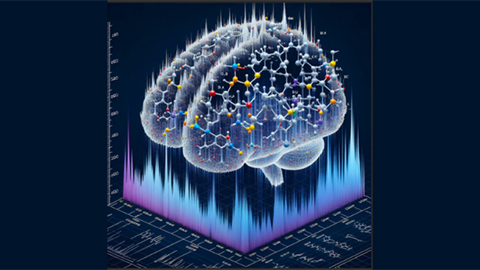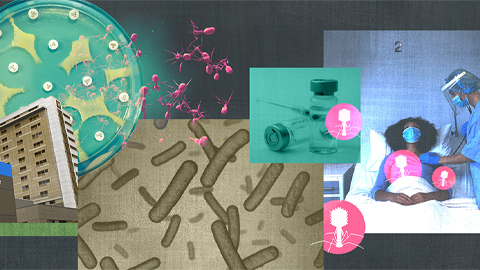Breastfeeding Awareness Month
The ASBMB observed National Breastfeeding Awareness Month, which included World Breastfeeding Week (the first week of August), by sharing research on breast milk published by the society’s journals. Learn about maternal nutrition, babies’ DHA production enzymes, infant microbiomes, breast milk peptides, immunity and more below.

Production
Early days of research: The complexity of breast milk was actively investigated in the early 20th century, with numerous studies in the Journal of Biological Chemistry using early biochemistry methods to investigate human milk’s nutritional content. In a 1916 study, one researcher asked whether breast milk produced by the same lactating mother changes over time. He found that the nutritional composition of breast milk might change as quickly as the newborn develops in the early days of life.
Protein digestion as milk gets made: Cells in the mammary gland that secrete milk contain highly specific proteases that break down some proteins but not others. This helps fill milk with peptides with biological activity. Until recently, we didn’t know much about the peptides present in milk or what they could do. In this article in the journal Molecular & Cellular Proteomics, researchers took a proteomic approach to find out which peptides are most abundant in human milk and what that can tell us about proteolysis in the mammary gland.
A pretty sweet study: Breast milk contains a variety of unique sugars, the functions of which are only beginning to be understood. In a functional glycomics study in the Journal of Biological Chemistry, researchers used a high-throughput glycan microarray to investigate how human milk glycans bind to diverse proteins, viruses and antibodies. The researchers identified glycans that bound flu viruses at low concentrations, leading them to propose that human milk glycans are a “liquid innate immune system.”
Consumption
Infant gut microbes’ thirst for milk glycoproteins: Milk is a complicated liquid. Among its ingredients, which include lactose, lipids, free oligosaccharides and proteins, the free oligosaccharides perform the essential prebiotic roles of stimulating the growth of beneficial bacteria and preventing harmful bacteria from binding to epithelial cells in the gut. In a paper published in the journal Molecular & Cellular Proteomics, researchers reported that the bacteria in infants’ guts are also capable of digesting glycoproteins.Read about the study.
Can babies make their own DHA? Docosahexanoic acid, or DHA, is an omega-3 unsaturated fatty acid crucial to brain and eye development. DHA is present in mammal milk and was thought to be delivered to newborns exclusively through their diet. But DHA also can be made from dietary alpha-linoleic acid. A study in the Journal of Lipid Research reported that mice with DHA-production enzymes born to mothers lacking those enzymes could develop normally. This suggests newborn mice are able to synthesize DHA themselves.
Does a maternal DHA supplement get passed on to babies? Maternal diets (especially vegetarianism) can dramatically affect the amount of DHA present in breast milk. In this Journal of Lipid Research article published in 2000, researchers reported that supplementing new mothers’ diets with DHA-rich capsules could increase the DHA present in their breast milk. They also tracked how a dose of DHA in the diet makes it into milk, finding that it takes six to 12 hours after consumption to peak but that three-quarters of milk DHA comes from body fat stores.
Effects
A dynamic defense protein: The protein lactoferrin, which is abundant in milk, has antibacterial properties that can protect a newborn from infection, sepsis and enterocolitis. Does that protection change as the baby grows and develops? This article in the journal Molecular & Cellular Proteomics reports how sugar modifications to lactoferrin change during the first few months of lactation. The authors found dramatic decreases in lactoferrin glycosylation in the first few weeks of life, during the transition from colostrum, or “first milk,” to mature milk. The researchers speculate that reduced glycosylation may make it easier for lactoferrin to be cleaved into antimicrobial peptides.
Fending off risky microbes: Newborn babies have underdeveloped immune systems that make them vulnerable to some bacteria that are harmless to adults. Group B streptococcus is a bacterium carried by many healthy mothers that can infect babies during birth. Researchers studying human milk made an unexpected discovery: Certain components of complex carbohydrates called human milk oligosaccharides can directly inhibit the growth of the bacterium. In the Journal of Biological Chemistry, the researchers explain that nonsialylated HMO fractions stop the growth of group B strep expressing a particular glycosyltransferase, possibly because these bacteria erroneously incorporate HMOs into their own cell walls. This study suggests that, in addition to helping babies develop their own immune systems, breast milk might directly help fight group B strep infections.
Feeding helpful microbes: In addition to helping babies fight off infections, breast milk has been proposed to help nourish beneficial bacteria, like bifidobacteria, allowing them to establish a stable population in newborns’ guts. Researchers investigated how bifidobacteria feeds on human milk oligosaccharides, publishing the results in the Journal of Biological Chemistry. Three species used different methods to metabolize HMOs and specialized on different HMO sub-types. Some left degraded HMO products behind, whereas others used up the entire sugar. The study hints at the complex process by which different types of bacteria share milk in their developing baby host.
How does a newborn’s diet affect cholesterol metabolism later in life? Breast milk has a high level of cholesterol. In this study published in the Journal of Lipid Research in 1995, researchers compared the effects of feeding baby baboons with formula or breast milk, which have different levels of cholesterol and saturated fatty acids. A recent endocrinology textbook, informed by this and other research, states that dietary cholesterol in newborns may have a beneficial effect on cholesterol metabolism later in life, because babies with a diet rich in cholesterol tend to synthesize less of the sterol. However, because of the numerous differences between breast milk and formula, the textbook’s authors caution that we still don’t understand the whole picture.
What can you learn from baby poop? Oligosaccharides, a type of complex sugar present in milk, stimulate the growth of beneficial bacteria. In this Molecular & Cellular Proteomics article, researchers report using baby poop to track which type of bacteria are present in infants’ microbiomes, based on which oligosaccharides make it through the gut unscathed and which are broken into their component parts.
Enjoy reading ASBMB Today?
Become a member to receive the print edition four times a year and the digital edition weekly.
Learn moreGet the latest from ASBMB Today
Enter your email address, and we’ll send you a weekly email with recent articles, interviews and more.
Latest in Science
Science highlights or most popular articles

RNA binding proteins with benefits
Blanton Tolbert studies the biochemical mechanisms of RNA virus replication while working to make science more accessible, and more interesting, for all people.

A proteomic hunt for phosphosites in the aging brain
In older mice, researchers found more enzymes that phosphorylate other proteins and changes in phosphorylation levels in proteins associated with neurodegeneration.

What if a virus could reverse antibiotic resistance?
In promising experiments, phage therapy forces bacteria into a no-win dilemma that lowers their defenses against drugs they’d evolved to withstand.

Tapping into bacterial conversations
Bonnie Bassler has helped usher in a new branch of science centered on quorum sensing, the process by which bacteria communicate with one another and orchestrate collective tasks.

From the journals: JLR
Can diacylglycerol combat athlete hyperuricemia? Inhibiting a cardiac enzyme improves metabolism. Targeting angiopoietins to combat liver injury. Read about papers on these topics recently published in the Journal of Lipid Research.

Liver enzyme holds key to adjusting to high-protein diets
Researchers at the University of Geneva show that glutamate dehydrogenase controls blood alkalinity during fasting.
